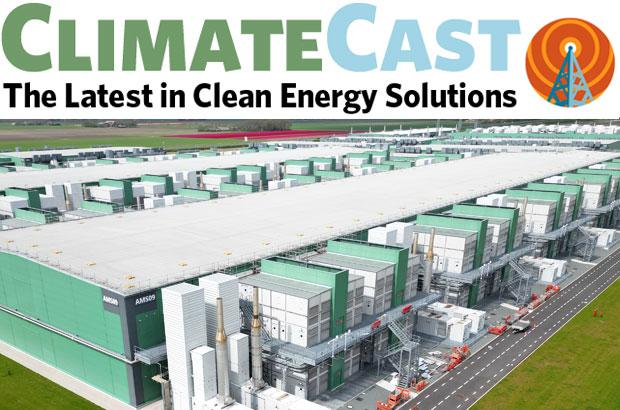What’s what in the Upper Left
The federal administration’s aggressive hostility towards clean energy and ongoing political retribution continues to impact Northwest states. The Department of Energy has canceled grants for clean energy projects to the tune of $1.1 billion in Washington State and $400 million in Oregon. But recent headlines from both states shows it will take more than a toxic political moment to dismantle the path to clean energy in the Northwest. Just this week both Washington and Oregon joined more than 20 states to sue the EPA and challenge its decision to cancel the $7 billion Solar For All program. The Washington State Supreme Court also declined to hear yet another challenge to the Climate Commitment Act (cap-and-invest) program. In Oregon, Gov. Kotek moved to fast track renewable energy projects directing state agencies to take “any and all steps necessary” in order to take advantage of federal tax credits that expire next year.
Data centers’ massive energy appetite: who is paying the cost?
Data centers are booming and with them the controversy: cheap land, big companies and big development, surging power demand, and the impacts to everyday people. It’s happening in Maryland and Virginia, the suburbs of Atlanta, Wyoming, Missouri, Arizona, New Mexico, to name a few–in fact there’s an average of 78 data centers in each state (Virginia has the most at 633). The surging demand for AI services is creating an urgent need for additional electricity, and threatening to raise household utility bills for families across the US. In areas with data centers, electricity can cost as much as 267% more than it did five years ago—a typical data center can consume as much electricity as 100,000 households. All of this power mongering is translating to higher energy bills for everyday people.These issues are likely to play out in this year’s elections with voters “mad as hell” about electricity prices. In addition, data centers and their associated carbon emissions are increasingly being built alongside communities with a history of environmental degradation and public health problems.
The media climate is in trouble, too
The current federal administration seems to glory in policy changes that turn back the clock on climate progress and environmental protection. At the same time, it has caused epic damage to our media environment and to the information ecosystem we all rely on for democratic engagement. On one level, there are the direct attacks on journalistic freedom—Trump has long called for critical journalists to be fired or even jailed; the White House press corps has been squeezed to privilege sycophants and punish critical questioners. This past week many of the journalists assigned to cover the Pentagon gave up access rather than accept extremely onerous rules limiting independent reporting. This year, the United States’ ranking in Reporters Without Borders’ international Press Freedom Index hit a historical low, and is now considered “problematic.”
The FCC is ostensibly an independent agency charged in part with protecting the airwaves for free expression. But Trump’s FCC has turned that on its head, most recently threatening the network ABC and its many affiliates with punishment if it failed to deplatform Jimmy Kimmel. The fact that the network leadership quickly complied (although a huge national outcry caused it to reverse itself days later) exemplifies another troubling trend of consolidated corporate media owners easily bending to anti-democratic directives from the Trump administration. The most egregious examples of this have come from CBS News. After a series of already-alarming capitulations to Trump in the course of settling a lawsuit earlier this year, the network announced that it was hiring the conservative writer Bari Weiss to head the news division. Victor Pickard, a media policy professor at the University of Pennsylvania, told the New York Times: “Taken together, the attacks on all of our media institutions is certainly unprecedented in modern American history. I can’t think of any parallel.”
Maybe the most damaging to the long-term health of the media environment is the administration’s withdrawal of funds from public broadcasting, causing the Corporation for Public Broadcasting to announce that it would shut down entirely. For nearly 60 years, the CPB operated mostly beyond the reach of partisan politics, supporting public broadcasting networks and hundreds of individual stations. While healthy public and community-run stations have long sought diverse sources of funding, the federal cuts are creating hard choices for many broadcasters. Rural stations are being hit the hardest, but layoffs and closures are affecting stations across the country. In the Northwest, Washington State University’s KWSU-TV will cease broadcasting. In Warm Springs, OR, the cuts may force tribal-run station KWSO-FM to drop its carriage of NPR programming. Seattle’s Cascade PBS recently laid off basically its entire newsroom, including journalists who had joined the station group after it absorbed the now-shuttered nonprofit news outlet Crosscut.
What we’re listening to: music to nourish
A falltime favorite on our stereo is David Sylvian’s Brilliant Trees (1984), whose seven songs always seem to encourage thoughtful moods and calm reflection, no matter what craziness is overtaking the world. The title track, a dreamily melancholy duet with trumpeter Jon Hassell, quietly unfolds over eight and a half minutes to release an ultimately mute, primordial optimism.
–Jonathan Lawson
You might already be familiar with Kokoroko, a British septet that’s known for its fusion of jazz, R&B, funk, and Afrobeats. I love that their music is described as “convey[ing] a radical mission to choose joy.” Check out their latest live performance on NPR’s Tiny Desk.
–Stephanie Noren
Source link
Stephanie Noren www.climatesolutions.org

